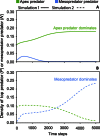Ecosystem context and historical contingency in apex predator recoveries
- PMID: 27386535
- PMCID: PMC4928970
- DOI: 10.1126/sciadv.1501769
Ecosystem context and historical contingency in apex predator recoveries
Abstract
Habitat loss, overexploitation, and numerous other stressors have caused global declines in apex predators. This "trophic downgrading" has generated widespread concern because of the fundamental role that apex predators can play in ecosystem functioning, disease regulation, and biodiversity maintenance. In attempts to combat declines, managers have conducted reintroductions, imposed stricter harvest regulations, and implemented protected areas. We suggest that full recovery of viable apex predator populations is currently the exception rather than the rule. We argue that, in addition to well-known considerations, such as continued exploitation and slow life histories, there are several underappreciated factors that complicate predator recoveries. These factors include three challenges. First, a priori identification of the suite of trophic interactions, such as resource limitation and competition that will influence recovery can be difficult. Second, defining and accomplishing predator recovery in the context of a dynamic ecosystem requires an appreciation of the timing of recovery, which can determine the relative density of apex predators and other predators and therefore affect competitive outcomes. Third, successful recovery programs require designing adaptive sequences of management strategies that embrace key environmental and species interactions as they emerge. Consideration of recent research on food web modules, alternative stable states, and community assembly offer important insights for predator recovery efforts and restoration ecology more generally. Foremost among these is the importance of a social-ecological perspective in facilitating a long-lasting predator restoration while avoiding unintended consequences.
Keywords: Restoration; apex predator; competition; food chain; hysteresis; intraguild predation; recovery.
Figures





References
-
- Sergio F., Schmitz O. J., Krebs C. J., Holt R. D., Heithaus M. R., Wirsing A. J., Ripple W. J., Ritchie E., Ainley D., Oro D., Jhala Y., Hiraldo F., Korpimäki E., Towards a cohesive, holistic view of top predation: A definition, synthesis and perspective. Oikos 123, 1234–1243 (2014).
-
- Yodzis P., Must top predators be culled for the sake of fisheries? Trends Ecol. Evol. 16, 78–84 (2001). - PubMed
-
- Estes J. A., Terborgh J., Brashares J. S., Power M. E., Berger J., Bond W. J., Carpenter S. R., Essington T. E., Holt R. D., Jackson J. B. C., Marquis R. J., Oksanen L., Oksanen T., Paine R. T., Pikitch E. K., Ripple W. J., Sandin S. A., Scheffer M., Schoener T. W., Shurin J. B., Sinclair A. R. E., Soulé M. E., Virtanen R., Wardle D. A., Trophic downgrading of planet Earth. Science 333, 301–306 (2011). - PubMed
-
- Ripple W. J., Newsome T. M., Wolf C., Dirzo R., Everatt K. T., Galetti M., Hayward M. W., Kerley G. I. H., Levi T., Lindsey P. A., Macdonald D. W., Malhi Y., Painter L. E., Sandom C. J., Terborgh J., Van Valkenburgh B., Collapse of the world’s largest herbivores. Sci. Adv. 1, e1400103 (2015). - PMC - PubMed
-
- Soulé M. E., Estes J. A., Berger J., del Rio C. M., Ecological effetiveness: Conservation goals for interactive species. Conserv. Biol. 17, 1238–1250 (2003).
Publication types
MeSH terms
LinkOut - more resources
Full Text Sources
Other Literature Sources
Miscellaneous

